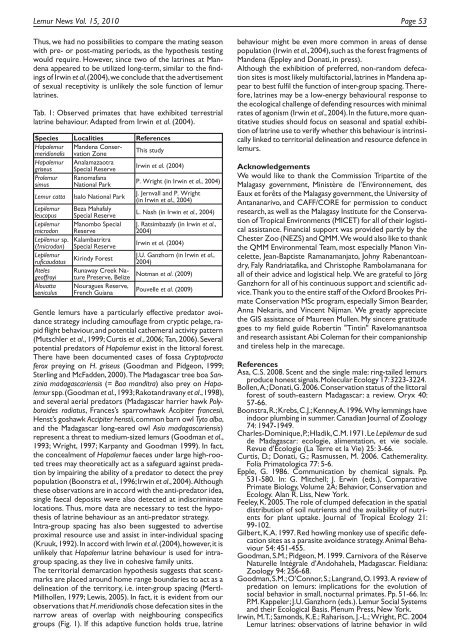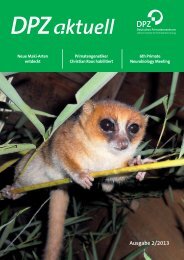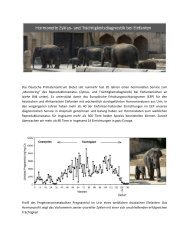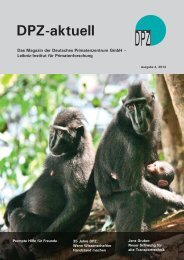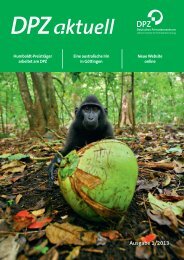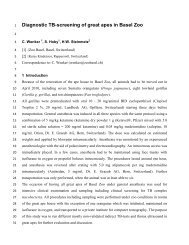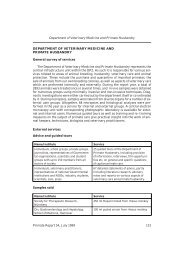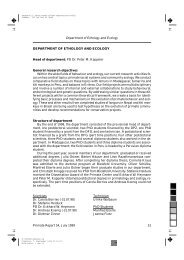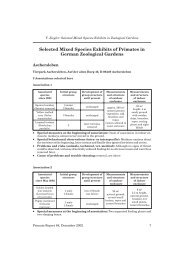Vol. 15 - Deutsches Primatenzentrum
Vol. 15 - Deutsches Primatenzentrum
Vol. 15 - Deutsches Primatenzentrum
You also want an ePaper? Increase the reach of your titles
YUMPU automatically turns print PDFs into web optimized ePapers that Google loves.
Lemur News <strong>Vol</strong>. <strong>15</strong>, 2010 Page 53<br />
Thus, we had no possibilities to compare the mating season<br />
with pre- or post-mating periods, as the hypothesis testing<br />
would require. However, since two of the latrines at Mandena<br />
appeared to be utilized long-term, similar to the findings<br />
of Irwin et al.(2004),we conclude that the advertisement<br />
of sexual receptivity is unlikely the sole function of lemur<br />
latrines.<br />
Tab. 1: Observed primates that have exhibited terrestrial<br />
latrine behaviour. Adapted from Irwin et al. (2004).<br />
Species Localities References<br />
Hapalemur<br />
meridionalis<br />
Mandena Conservation<br />
Zone<br />
This study<br />
Hapalemur<br />
griseus<br />
Analamazaotra<br />
Special Reserve<br />
Irwin et al. (2004)<br />
Prolemur<br />
simus<br />
Ranomafana<br />
National Park<br />
P. Wright (in Irwin et al., 2004)<br />
Lemur catta Isalo National Park<br />
J. Jernvall and P. Wright<br />
(in Irwin et al., 2004)<br />
Lepilemur<br />
leucopus<br />
Beza Mahafaly<br />
Special Reserve<br />
L. Nash (in Irwin et al., 2004)<br />
Lepilemur Manombo Special J. Ratsimbazafy (in Irwin et al.,<br />
microdon Reserve<br />
2004)<br />
Lepilemur sp.<br />
(?microdon)<br />
Kalambatritra<br />
Special Reserve<br />
Irwin et al. (2004)<br />
Lepilemur<br />
ruficaudatus<br />
Kirindy Forest<br />
J.U. Ganzhorn (in Irwin et al.,<br />
2004)<br />
Ateles<br />
geoffroyi<br />
Runaway Creek Nature<br />
Preserve, Belize<br />
Notman et al. (2009)<br />
Alouatta<br />
seniculus<br />
Nouragues Reserve,<br />
French Guiana<br />
Pouvelle et al. (2009)<br />
Gentle lemurs have a particularly effective predator avoidance<br />
strategy including camouflage from cryptic pelage, rapid<br />
flight behaviour,and potential cathemeral activity pattern<br />
(Mutschler et al., 1999; Curtis et al., 2006; Tan, 2006). Several<br />
potential predators of Hapalemur exist in the littoral forest.<br />
There have been documented cases of fossa Cryptoprocta<br />
ferox preying on H. griseus (Goodman and Pidgeon, 1999;<br />
Sterling and McFadden,2000).The Madagascar tree boa Sanzinia<br />
madagascariensis (= Boa manditra) also prey on Hapalemur<br />
spp.(Goodman et al.,1993;Rakotandravany et al.,1998),<br />
and several aerial predators (Madagascar harrier hawk Polyboroides<br />
radiatus, Frances’s sparrowhawk Accipiter francesii,<br />
Henst’s goshawk Accipiter henstii,common barn owl Tyto alba,<br />
and the Madagascar long-eared owl Asio madagascariensis)<br />
represent a threat to medium-sized lemurs (Goodman et al.,<br />
1993; Wright, 1997; Karpanty and Goodman 1999). In fact,<br />
the concealment of Hapalemur faeces under large high-rooted<br />
trees may theoretically act as a safeguard against predation<br />
by impairing the ability of a predator to detect the prey<br />
population (Boonstra et al.,1996;Irwin et al.,2004).Although<br />
these observations are in accord with the anti-predator idea,<br />
single faecal deposits were also detected at indiscriminate<br />
locations. Thus, more data are necessary to test the hypothesis<br />
of latrine behaviour as an anti-predator strategy.<br />
Intra-group spacing has also been suggested to advertise<br />
proximal resource use and assist in inter-individual spacing<br />
(Kruuk,1992).In accord with Irwin et al.(2004),however,it is<br />
unlikely that Hapalemur latrine behaviour is used for intragroup<br />
spacing, as they live in cohesive family units.<br />
The territorial demarcation hypothesis suggests that scentmarks<br />
are placed around home range boundaries to act as a<br />
delineation of the territory, i.e. inter-group spacing (Mertl-<br />
Millhollen, 1979; Lewis, 2005). In fact, it is evident from our<br />
observations that H.meridionalis chose defecation sites in the<br />
narrow areas of overlap with neighbouring conspecifics<br />
groups (Fig. 1). If this adaptive function holds true, latrine<br />
behaviour might be even more common in areas of dense<br />
population (Irwin et al.,2004),such as the forest fragments of<br />
Mandena (Eppley and Donati, in press).<br />
Although the exhibition of preferred, non-random defecation<br />
sites is most likely multifactorial,latrines in Mandena appear<br />
to best fulfil the function of inter-group spacing. Therefore,<br />
latrines may be a low-energy behavioural response to<br />
the ecological challenge of defending resources with minimal<br />
rates of agonism (Irwin et al.,2004).In the future,more quantitative<br />
studies should focus on seasonal and spatial exhibition<br />
of latrine use to verify whether this behaviour is intrinsically<br />
linked to territorial delineation and resource defence in<br />
lemurs.<br />
Acknowledgements<br />
We would like to thank the Commission Tripartite of the<br />
Malagasy government, Ministère de l’Environnement, des<br />
Eaux et forêts of the Malagasy government,the University of<br />
Antananarivo, and CAFF/CORE for permission to conduct<br />
research, as well as the Malagasy Institute for the Conservation<br />
of Tropical Environments (MICET) for all of their logistical<br />
assistance. Financial support was provided partly by the<br />
Chester Zoo (NEZS) and QMM.We would also like to thank<br />
the QMM Environmental Team, most especially Manon Vincelette,<br />
Jean-Baptiste Ramanamanjato, Johny Rabenantoandry,<br />
Faly Randriatafika, and Christophe Rambolamanana for<br />
all of their advice and logistical help. We are grateful to Jörg<br />
Ganzhorn for all of his continuous support and scientific advice.Thank<br />
you to the entire staff of the Oxford Brookes Primate<br />
Conservation MSc program, especially Simon Bearder,<br />
Anna Nekaris, and Vincent Nijman. We greatly appreciate<br />
the GIS assistance of Maureen Mullen. My sincere gratitude<br />
goes to my field guide Robertin "Tintin" Ravelomanantsoa<br />
and research assistant Abi Coleman for their companionship<br />
and tireless help in the marecage.<br />
References<br />
Asa, C.S. 2008. Scent and the single male: ring-tailed lemurs<br />
produce honest signals.Molecular Ecology 17:3223-3224.<br />
Bollen,A.;Donati,G.2006.Conservation status of the littoral<br />
forest of south-eastern Madagascar: a review. Oryx 40:<br />
57-66.<br />
Boonstra,R.;Krebs,C.J.;Kenney,A.1996.Why lemmings have<br />
indoor plumbing in summer.Canadian Journal of Zoology<br />
74: 1947-1949.<br />
Charles-Dominique,P.;Hladik,C.M.1971.Le Lepilemur de sud<br />
de Madagascar: ecologie, alimentation, et vie sociale.<br />
Revue d’Écologie (La Terre et la Vie) 25: 3-66.<br />
Curtis, D.; Donati, G.; Rasmussen, M. 2006. Cathemerality.<br />
Folia Primatologica 77: 5-6.<br />
Epple, G. 1986. Communication by chemical signals. Pp.<br />
531-580. In: G. Mitchell; J. Erwin (eds.), Comparative<br />
Primate Biology, <strong>Vol</strong>ume 2A: Behavior, Conservation and<br />
Ecology. Alan R. Liss, New York.<br />
Feeley,K. 2005.The role of clumped defecation in the spatial<br />
distribution of soil nutrients and the availability of nutrients<br />
for plant uptake. Journal of Tropical Ecology 21:<br />
99-102.<br />
Gilbert, K.A. 1997. Red howling monkey use of specific defecation<br />
sites as a parasite avoidance strategy.Animal Behaviour<br />
54: 451-455.<br />
Goodman, S.M.; Pidgeon, M. 1999. Carnivora of the Réserve<br />
Naturelle Intégrale d’Andohahela, Madagascar. Fieldiana:<br />
Zoology 94: 256-68.<br />
Goodman,S.M.;O’Connor,S.;Langrand,O.1993.A review of<br />
predation on lemurs: implications for the evolution of<br />
social behavior in small, nocturnal primates. Pp. 51-66. In:<br />
P.M.Kappeler;J.U.Ganzhorn (eds.). Lemur Social Systems<br />
and their Ecological Basis. Plenum Press, New York.<br />
Irwin, M.T.; Samonds, K.E.; Raharison, J.-L.; Wright, P.C. 2004<br />
Lemur latrines: observations of latrine behavior in wild


